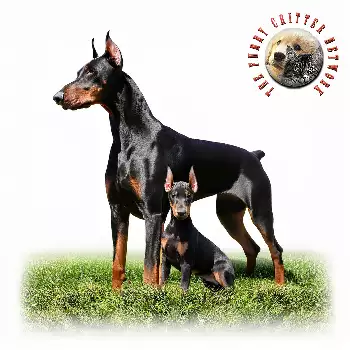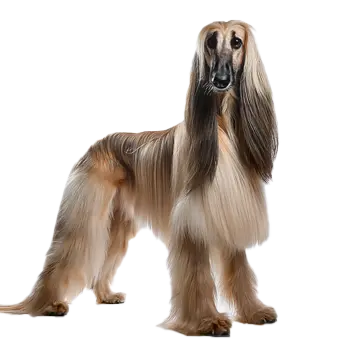Doberghan
Hybrid Breed Description
The Doberghan is a cross between the Doberman Pinscher and the Afghan Hound. Because each hybrid inherits a unique combination of traits from both parents, we recommend thoroughly researching both breeds before choosing a Doberghan. Pay special attention to temperament, health issues, and care requirements, as your dog may express characteristics from either parent breed.
Doberman Pinscher

The Doberman Pinscher presents a sleek and powerful appearance that commands attention. Males typically stand between 26 and 28 inches at the shoulder while weighing 75 to 100 pounds, whereas females measure 24 to 26 inches in height with weights ranging from 60 to 90 pounds. This medium to large breed exhibits a square-bodied, smoothly muscled frame with an elegant yet athletic build. The breed's distinctive silhouette features a long, wedge-shaped head, a strong arched neck that flows into smooth shoulders, and a level topline that appears to continue seamlessly into the tail. The chest is broad and deep, supported by perfectly straight, sturdy legs that convey both strength and agility. The Doberman's short, hard, thick coat lies flat against the body and comes in four recognized colors: black, red, blue, and fawn (Isabella), each accompanied by sharply defined rust-colored markings. These rust markings appear above each eye, on the muzzle, throat, forechest, all legs and feet, and below the tail, creating the breed's signature appearance. The coat has a smooth, glossy finish with minimal grooming requirements, though a barely visible gray undercoat may be present on the neck. The breed's overall appearance conveys an impression of power, elegance, and determination, with every aspect of their physique designed for strength, speed, and endurance without sacrificing grace or coordination.
Key Characteristics
Doberman Pinschers are renowned for their exceptional intelligence, ranking among the smartest dog breeds and excelling in activities requiring complex cognitive skills such as obedience trials and agility. They possess an extraordinary combination of energy, loyalty, and playfulness within their family circle, demonstrating unparalleled devotion and forming strong, enduring bonds with their owners. As natural protectors, Dobermans act promptly when perceiving threats to loved ones, yet they do not display aggression without cause and maintain a gentle, affectionate demeanor with family members. The breed exhibits a people-oriented nature, actively seeking human attention and companionship, though they can be reserved or aloof with strangers until properly introduced. Energetic and determined, Dobermans require substantial physical and mental stimulation to prevent boredom and destructive behaviors. They are highly trainable and respond exceptionally well to positive reinforcement, though they can be sensitive to harsh correction and require patient, firm, and consistent guidance. The breed maintains an alert, watchful disposition, remaining aware of their environment at all times with astonishing hearing and sense of smell. While Dobermans possess strong protective instincts, proper early socialization and training are essential to ensure they develop into well-adjusted, well-mannered companions who can distinguish between genuine threats and normal situations, making them excellent family guardians when raised with appropriate leadership.
Doberman Pinschers face several significant health concerns that potential owners should carefully consider. The most serious is dilated cardiomyopathy (DCM), a degenerative heart condition affecting 5.8 to 7.32 percent of the breed, with Dobermans experiencing more severe outcomes than other breeds, showing an average survival time of just 52 days compared to 240 days for other breeds affected by this disease. This breed-specific vulnerability stems from a unique fatty infiltration-degenerative type of DCM that appears specific to Dobermans and Boxers. Additionally, Dobermans are predisposed to Von Willebrand disease, a congenital bleeding disorder caused by deficiency in Von Willebrand factor, making pre-surgical testing advisable for this breed. Beyond cardiac concerns, Dobermans may experience various orthopedic and systemic health issues throughout their lives. Hip dysplasia, a hereditary condition where the thighbone doesn't fit properly into the hip joint, can develop and lead to arthritis as the dog ages. The breed also shows susceptibility to hypothyroidism, wobbler syndrome (a neurological condition causing gait abnormalities), and copper hepatopathy, a liver disorder characterized by excessive copper accumulation that can manifest between ages two to four with symptoms of jaundice. Eye conditions including progressive retinal atrophy and glomerulonephritis (a kidney disease) are additional concerns. The typical lifespan ranges from 10 to 12 years, making regular veterinary checkups, appropriate screening tests, and preventive care essential for maintaining optimal health throughout the Doberman's life.
Afghan Hound

The Afghan Hound is a medium to large sighthound standing 25 to 27 inches at the shoulder and weighing between 50 and 60 pounds, presenting one of the most distinctive and elegant profiles in the dog world. The breed's regal appearance features a long, narrow, refined head with a slightly convex muzzle giving a Roman appearance, dark almond-shaped eyes that convey intelligence and dignity, and long ears covered with even longer silky hair. The breed exhibits prominent high hipbones, an arched neck, large paw-pads that once served as shock absorbers on rocky terrain, and a distinctive tail ending in a ring or doughnut bend carried high with a slight curve. The Afghan's strong, powerful body shows a seemingly exaggerated bend at the knees, contributing to the breed's characteristic elastic, powerful stride. The Afghan Hound's most striking feature is its long, fine-textured, flowing coat that requires considerable care and grooming. The distinctive coat pattern includes a long silky topknot on the head, thick coverage on the forequarters, chest, flanks, hindquarters, and legs, while the face and back (saddle) feature short, glossy hair. This luxurious coat, developed as protection from harsh mountain climates, can appear in any color including black, black and tan, red, cream, blue, brindle, domino, and white, with many dogs displaying a range of hues. Afghan puppies look quite different from adults, sporting fuzzy facial hair called monkey whiskers and a short, fluffy coat over their saddles that begins transforming into the characteristic long adult coat around one year of age, creating the breed's signature glamorous appearance.
Key Characteristics
Afghan Hounds possess a complex and dignified temperament characterized by independence, intelligence, and a somewhat aloof nature that reflects their ancient heritage as hunters bred to think autonomously. The breed exhibits a personality spectrum ranging from fiercely brave to occasionally timid, from flighty and energetic to quiet and lazy, and from dignified aristocrat to downright clownish, particularly when playing with loved ones. While strongly loyal and devoted to their families, Afghans can be quite reserved and wary of strangers, requiring extensive early socialization to prevent development of a feral or overly suspicious disposition. Their independent, strong-willed nature makes them challenging to train despite their high intelligence, as they respond poorly to harsh correction and require gentle guidance combined with firm, patient, consistent discipline. As sighthounds, Afghan Hounds maintain an exceptionally high prey drive and natural instinct to chase, making secure fencing and leash control absolutely essential, as no amount of training will override this deeply ingrained hunting behavior. The breed requires substantial daily exercise, ideally including at least two hours of activity combining long walks or runs with opportunities for free running in securely fenced areas. Despite their athletic nature and high exercise needs, Afghans can adapt to apartment living and display couch potato tendencies when properly exercised. Their sensitivity and attachment to routines mean they don't handle change well and may experience distress when left alone for extended periods or when their environment or schedule is disrupted, making them best suited for owners who can provide consistent companionship and structured daily routines.
Afghan Hounds are generally healthy dogs, though their unique physical characteristics and ancient lineage predispose them to certain breed-specific health concerns requiring vigilant monitoring. Hip dysplasia, a hereditary condition where the hip joint develops improperly, can lead to arthritis and mobility challenges as the dog ages, making screening through the Orthopedic Foundation for Animals or similar programs advisable for breeding stock. The breed may experience eye disorders including progressive retinal atrophy and cataracts that can impact vision and potentially lead to blindness if left untreated, necessitating regular ophthalmologic examinations. Additionally, Afghan Hounds can be affected by hypothyroidism, a thyroid hormone deficiency causing symptoms such as weight gain, lethargy, and coat problems that responds well to lifelong medication. Beyond these common concerns, Afghan Hounds face several other health considerations related to their distinctive conformation and metabolism. The breed shows sensitivity to anesthesia due to their low body fat percentage, requiring veterinarians experienced with sighthounds to carefully monitor dosing during surgical procedures. Bloat (gastric dilatation-volvulus) poses a life-threatening risk, particularly given the breed's deep chest structure, making awareness of symptoms and preventive feeding practices essential. Allergies affecting skin and coat health can develop, requiring dietary adjustments or medical management. The Afghan's elaborate coat demands meticulous care to prevent skin infections, particularly in the wrinkles and folds that can trap moisture and debris. With proper care, regular veterinary checkups, and attention to their unique needs, Afghan Hounds typically enjoy a lifespan of 12 to 14 years, though maintaining their health requires commitment to their extensive grooming needs and exercise requirements.
Important to Remember
Each hybrid dog is unique and may inherit any combination of traits from either parent breed. The information above represents the characteristics of the purebred parent breeds. Your Doberghan may favor one parent over the other or display a blend of both. We strongly encourage you to read the complete breed profiles for both the Doberman Pinscher and Afghan Hound to fully understand the range of possible temperaments, health concerns, and care requirements.